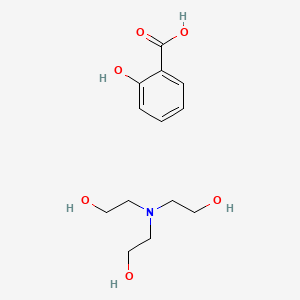



1. Myoflex
2. Triethanolamine Salicylate
1. Triethanolamine Salicylate
2. 2174-16-5
3. Tea-salicylate
4. Neo Heliopan Ts
5. Tea Salicylate
6. Neotan W
7. Salicylic Acid Trolamine
8. H8o4040bhd
9. 2-hydroxybenzoic Acid, Compd. With 2,2',2''-nitrilotris(ethanol) (1:1)
10. Trolamine Salicylate (usp)
11. Trolamine Salicylate [usp]
12. Benzoic Acid, 2-hydroxy-, Compd. With 2,2',2''-nitrilotris(ethanol) (1:1)
13. Arthricream
14. Myoflex
15. Sunarome W
16. Benzoic Acid, 2-hydroxy-, Compd. With 2,2',2''-nitrilotris[ethanol] (1:1)
17. Arthricream (tn)
18. Dsstox_cid_27945
19. Dsstox_rid_82697
20. Unii-h8o4040bhd
21. Dsstox_gsid_47969
22. Schembl15847
23. Salicylic Acid Triethanolamine
24. Tea-salicylate [inci]
25. Chembl2107288
26. Dtxsid4047969
27. 2-[bis(2-hydroxyethyl)amino]ethanol;2-hydroxybenzoic Acid
28. Triethanolamine, Salicylate
29. Salicylic Acid Triethanolamine Salt
30. Einecs 218-531-3
31. Tox21_201084
32. Trolamine Salicylate [mart.]
33. Trolamine Salicylate [who-dd]
34. Db11079
35. Triethanolamine Salicylate [mi]
36. Ncgc00248985-01
37. Ncgc00258636-01
38. Triethanolamine Salicylate [vandf]
39. Cas-2174-16-5
40. Trolamine Salicylate [usp Impurity]
41. Trolamine Salicylate [usp Monograph]
42. Ft-0708839
43. 2,2',2''-nitrilotriethanol 2-hydroxybenzoate
44. D08501
45. Q7845153
46. Salicylic Acid, Compound With 2,2',2''-nitrilotriethanol (1:1)
| Molecular Weight | 287.31 g/mol |
|---|---|
| Molecular Formula | C13H21NO6 |
| Hydrogen Bond Donor Count | 5 |
| Hydrogen Bond Acceptor Count | 7 |
| Rotatable Bond Count | 7 |
| Exact Mass | 287.13688739 g/mol |
| Monoisotopic Mass | 287.13688739 g/mol |
| Topological Polar Surface Area | 122 Ų |
| Heavy Atom Count | 20 |
| Formal Charge | 0 |
| Complexity | 189 |
| Isotope Atom Count | 0 |
| Defined Atom Stereocenter Count | 0 |
| Undefined Atom Stereocenter Count | 0 |
| Defined Bond Stereocenter Count | 0 |
| Undefined Bond Stereocenter Count | 0 |
| Covalently Bonded Unit Count | 2 |
Indicated for the temporary relief of aches, and pains of muscles and joints associated with backache, lumbago, strains, bruises, sprains and arthritic or rheumatic pain, pain of tendons and ligaments.
Trolamine salicylate is a salicylate that inhibits cyclo-oxygenase (COX) enzymes responsible for generating pro-inflammatory factors such as to induce pain and inflammation. It is thought to mediate its analgesic effect through inhibition of COX-2 enzyme, which is an induced enzyme responsible for inflammatory responses and pain in muscle and joint disorders. By inhibiting fatty acid COX enzyme, trolamine salicylate inhibits the production of prostaglandins and thromboxanes in inflammatory cells involved in generating pain and inflammation. It thereby works to temporarily reduce mild to moderate pain. In subjects with muscle soreness from exercise, administration of topical trolamine salicylate was associated with reduced duration and severity of muscule soreness compared to placebo. In subjects with osteoarthritis in hands, trolamine salicylate cream was shown to be effective in achieving temporary relief of minor pain and stiffness.
Absorption
Following topical administration of 10% trolamine salicylate in healthy volunteers, salicylic acid could not be detected in serum indicating low systemic absorption.
Route of Elimination
Following topical administration of 10% trolamine salicylate in healthy volunteers, urinary recovery of total salicylate during the first 24 hours was 6.9 mg (p < 0.05), which is 1.4% of total dose.
Volume of Distribution
Topical administration of 1 gram of 10% trolamine salicylate in abdominal rat skin resulted in an approximate extravascular volume of distribution (V/F) of 24.0 mL.
Inflammation and tissue damage in different conditions including arthritis, bursitis, joint disorder, bruises, and strains or sprains of muscle origin, induce mild to moderate pain and are associated with increase prostaglandin synthesis. This is thought to be a result of COX-2 enzyme induction. COX-2 is induced in inflammatory cells in case of cell injury, infection or activation from inflammatory cytokines such as interleukin (IL)-1 and tumor necrosis factor (TNF)-. Upon activation, COX-2 produces prostanoid mediators of inflammation such as prostaglandins and thromboxanes. Trolamine salicylate mediates its analgesic effect by inhibiting the production of inflammatory mediators that sensitize nociceptive nerve endings and generate pain.